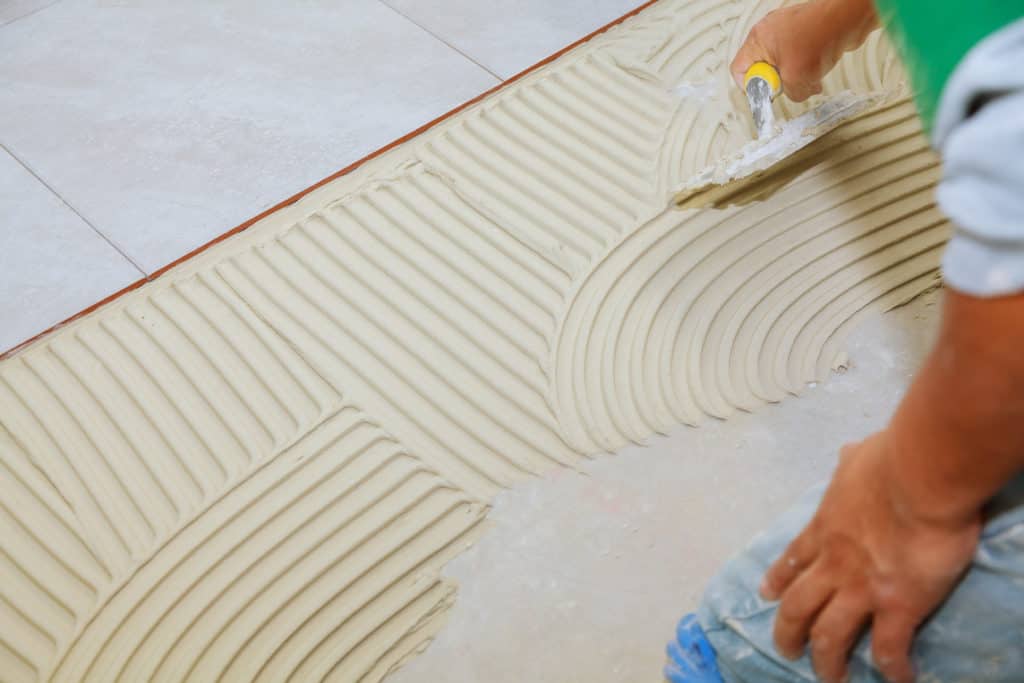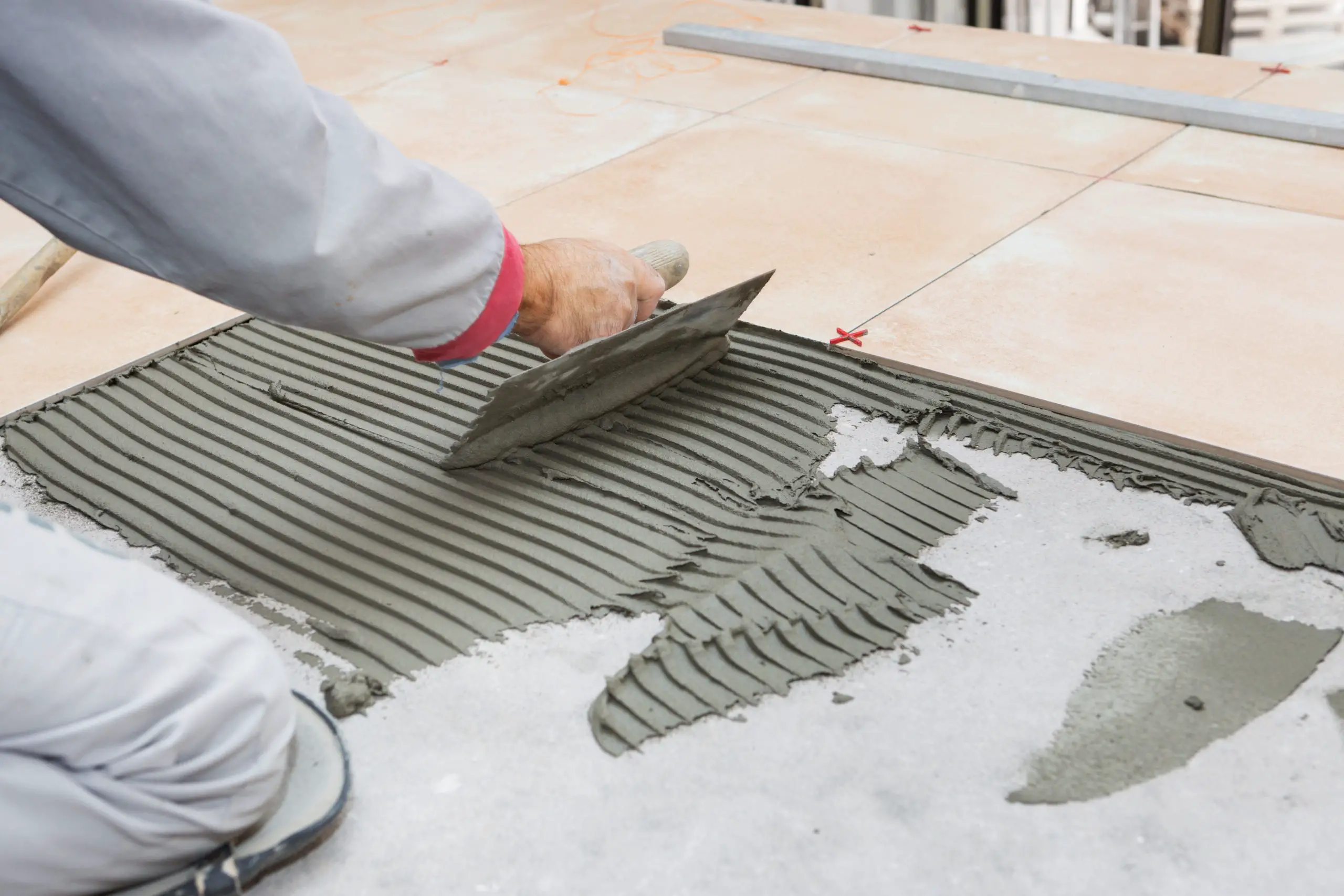
Are you looking to install new tile in your home? Are you unsure if you should use tile adhesive, cement, or maybe a little of both?
DO NOT mix tile adhesive with cement. Tile adhesive has other helpful properties when compared to cement that if mixed with cement will become obsolete. Tile adhesive and cement are much better binding substances when used separately.
So, what is the difference between tile adhesive and cement?
Tile Adhesive
What is tile adhesive? Like cement, it is a binding substance used to bind tiles, glass mosaics, and other such materials to drywalls, floors, existing tiles, external areas like parking lots, pools, and more. It is most typically used with tiling, specifically the tiny mosaic tiling that requires a steady hand to install. However, tile adhesive is not the mortar or grout used in between tiles. It’s just what sticks the tiles to the floor or wall.
Tile adhesive is made from a mixture of cement, sand, re-dispersible latex powder, methylcellulose ether, and other additives. The latex powder is meant to increase the bonding strength and tension between the tile and the floor. Methylcellulose ether thickens the solution and helps prevent moisture from seeping in.
These other additives are mixed in with the regular cement and sand to improve the quality of binding. Mixing it with more cement practically negates those special additives that make the tile adhesive unique, better, and more useful.
Pros & Cons: Tile Adhesive

Pros
- Easy to use. Tile adhesive often comes in a powder form that only needs water to thicken it into a paste. It is also a smoother texture that is easier to spread.
- Lightweight. It is much lighter compared to cement. It will put less strain on buildings if used at higher levels.
- Easily adjustable. When placing tiles on adhesive, the surface does not dry right away, allowing a little bit of movement to place the tile perfectly.
- No wasted material. There is little wasted material because it does not dry quickly, meaning that more batches will not need to be made frequently to accommodate the drying substance.
- Bonding adhesion. The bonding of tiles using tile adhesive is much more binding when compared to other binding substances.
- Covers more area. With the easy application of tile adhesives, the area in which it is applied fills in more gaps than cement. There are fewer gaps between the tiles and the surface on which it is being applied, making the tiles last longer.
- Lasts longer. Tile adhesive does not need much upkeep and protects tiles from moisture better.
- No soak. When using tile adhesive, there is no need to soak your tiles before installing them. Just lay the adhesive and stick the tile!
- Dries quickly. After placing tiles, tile adhesive only takes about 24 hours to dry, and 4 to 6 if you choose a fast-drying adhesive. That sounds contrary to a previous point, but it’s true!
Cons
- Expensive. One quart of tile adhesive is around $7, but if you’re looking to tile a large area, one quart isn’t going to cut it. A gallon is around $24, a 3.5 gallon is around $37, but a whole pallet of the adhesive could cost $1000. It just depends on how much surface area you need to cover. Here are different companies that offer different prices of tile adhesives: Home Depot, Ace Hardware, and Amazon.
Cement
Cement is a binding substance used in homes, places of business, and almost every other building you can think of. It is a key component in concrete, mortar, and grout. It is never used alone. After being set, hardening, and drying, it binds the tiles to the floor or wall.
This important substance is created from a variety of ingredients including shale, marl, bauxite, iron ore, chalk, clay, sand, and, the most important, limestone. If you’re interested in how cement is made, here is a handy video explaining the entire process!
When cement is used in tile installation, it is often combined with a sand slurry, making concrete. It is spread across the desired area and then the tiles are placed on time. After it has hardened, the tiles will stay stuck to the surface, requiring no other additive.
Pros & Cons: Cement
Pros

- Strength. Cement has unparalleled strength in any environment, which is why it is used outdoors so much.
- Durability. Cement lasts a long time. Only after many years will cement require removal and replacement. It is wind and water-resistant.
- Low maintenance. Because of its longevity and durability, there is no maintenance, if any, that is required for cement and concrete.
- Cheap. Because cement is used more often for a variety of projects, it is a much cheaper option compared to tile adhesive.
Cons
- Shrinks. When it dries, cement shrinks, causing pockets and inconsistencies underneath tiles. This is very problematic when water seems under and, with time, will cause cracks in the tiles.
- Aesthetic. With the inconsistent laying of tiles and the pockets of air, comes an aesthetic problem. The tiles are then of differing heights and angles.
- Needs to be perfect. Because cement is not as forgiving as tile adhesive, placing the tiles perfectly the first time is important. There is no wiggle room for mistakes.
- Time-consuming. Before placing tiles on the cement, they must be soaked for 20-30 minutes. This takes up a lot of time that could’ve been spent laying the tiles. That doesn’t even include the delicate nature of laying the tiles perfectly.
- Dry time. Cement is going to take a long time to completely dry. For the cement to be solid, it will take 28 days. Though the surface will dry and change color within the first few days, the middle will not be dry yet.
- Wasted material. Because cement will dry a bit more quickly on the surface, it will cause flakes and clumps that would create more pockets of air and then cracks in tiles.
DIY Tile Laying
If you’re looking to lay your own tile using tile adhesive, here is a handy video instructing how to use tile adhesive when laying tiles.
If you’re looking to lay your own tile using cement mortar, here is another handy video instructing how to use cement mortar. The video is a bit long, so you could watch until minute 3 where he then begins talking about cutting tiles.

